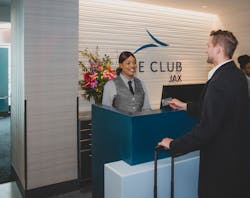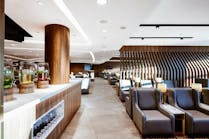Secondary airports are thriving. In the past, smaller airports meant secondary services and facilities, but not today. Low-cost carriers (LLCs) are streaming into secondary airports, and they’re buzzing with activity. That means more passengers who need more spaces to relax and refresh between flights. For LLCs that want to pamper their passengers, shared use lounges are quickly becoming the obvious solution.
In the next 20 years, passenger demand for air travel is projected to double. Already, the nation’s primary airports are clogged with traffic. In response, domestic and international LLCs are turning to secondary airports. For instance, LLCs such as Norwegian Air have added direct flights from the U.S. to Europe, operating out of Oakland rather than San Francisco. Southwest Airlines maintains hubs at the smaller Dallas-Love Field, Houston Hobby, and Chicago-Midway airports. And a handful of new international carriers are now flying in to Mineta San Jose International in California, creating unprecedented growth at this airport. Generally, secondary airports offer lower landing fees, fuel costs, and shorter ground time between flights. Now that the traffic is there, these airports must compete by offering a passenger experience that are too good to forget.
For passengers, secondary airports offer a relaxed atmosphere with quick access to parking and gates. Even more important, secondary airports give passengers direct and easy connectivity to the ‘last mile’ of their journey. What they haven’t been providing is the same quality lounge experience provided by the larger airports, but that’s changing. As more and more LLCs fly into secondary markets, they must find ways to compete with each other, and providing premium services to transiting passengers is a great way to do just that.
However, it doesn’t always make financial sense to invest in a lounge open to passengers from only one airline. For most LLCs, shared independent lounges are the ideal solution because they can serve a wider audience at a price point consistent with their low cost positioning. No membership required. Many credit card companies offer lounge access programs, and passengers can buy a day pass at most independently operated shared lounges. Thus, shared lounges are inclusive; they democratize comfort and hospitality for all passengers regardless of airline, class of ticket, or Frequent Flyer status.
Of course, traveler demands differ by generation. A recent study by The Collinson Group discovered that Baby Boomers make pampering a priority during vacations, but less than half of them require an airport lounge. Gen X travelers are looking for family-oriented activities, which maybe why 48 percent of them favor an airport lounge to rest in. Millennials travel more often, seeking “once-in-a-lifetime” experiences at a low price point, but 53 percent of them still want that airport lounge.
The difference in generational needs helps explain the need for personalized experiences. Most independent lounges offer snacks and beverages, Wi-Fi, charging stations, newspapers, and other standard amenities. However, some secondary airports are now offering lounges with separate zones for business and leisure travelers of any generation. They even offer unique amenities such as personal showers, private phone booths, workstations, meditation rooms, and playrooms for children. The Club network of lounges is an example of an independent lounge where passengers can find the perfect zone for them as they prepare for the next leg of their journey.
For even more memorable passenger experiences, secondary airports are partnering with local entertainment, restaurants, coffee shops, and breweries. Many secondary airports across Asia and Europe are already creating spaces and amenities that create that memorable traveler experience — both on the concourse and in the airport’s lounges. In the United States, Austin-Bergstrom International in Austin, TX hosts more than a dozen live concerts every week, entertaining transit passengers and introducing them to the local culture. Airports in the San Francisco Bay Area feature tasting rooms where travelers can sample Napa Valley wines between flights. The trend toward the pampered passenger is growing worldwide.
Thousands of travelers fly in and out of secondary airports every day. A new trend is transforming these airports into more than just a waiting room between departure and destination. With improved passenger amenities, airports and independent lounges are becoming part of the travel experience. Soon, any traveler will be able to find a space to relax and refuel before and between flights.
Nancy Knipp is the Senior Vice President at Airport Lounge Development.





